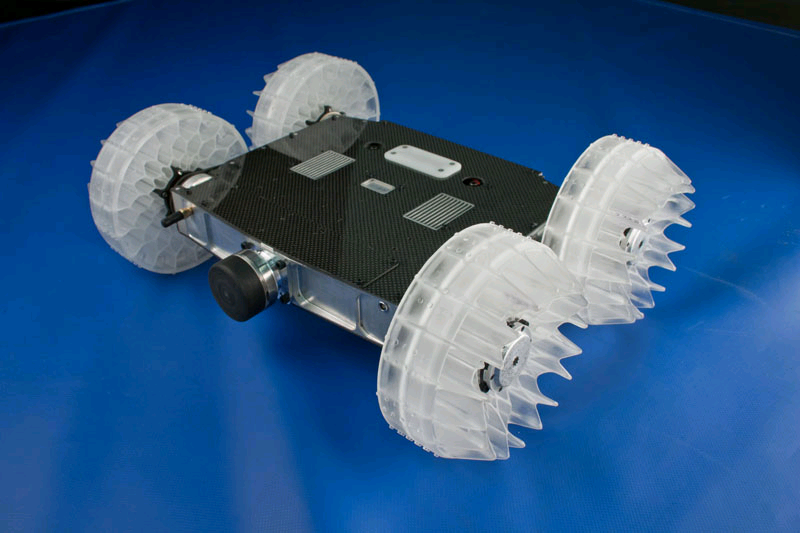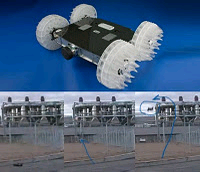Introduction
Sand flea robot like many other robots was inspired by the sand flea (Wagstaff 2011). This was due to the big hurdle that soldiers faced in the task of getting over walls and getting into the danger of getting trapped or ambushed by their enemies.

The idea of Sand Flea robot was first thought about by Arny Colonel Newell in 2011. He heads the Rapid Equipping Force and wondered how such wall as those in Afghanistan could be penetrated with maximum safety. Most walls separating walls in Afghanistan are around 18 feet high. If a troop ambushed such a compound, there was likelihood that they could be ambushed or trapped in bobby traps. Moreover, it was tedious since the soldiers had their 100 pound bags on their backs which could even put their lives and the operation at a big risk.
Discussion
Design
Sand Flea robot was first designed in the Pentagon Defense Advanced Research Projects Agency. When the agency felt it was successful, they sent the design over to the Boston Dynamics and Sandia National Laboratories for the actual making. The design had it that the robot would be shaped like a laptop with four wheels mounted on it. The wheels would be special to allow the robot to move even in the rough terrain that it might land into when in use. On it, is mounted a strong camera that would be used and connected to the squadron controlling it so as to have a view of what is beyond the walls the robot jumps over. The main objective of the development of the robot was to get over walls. This was very successful in the design because Sand Flea can jump over a 24 feet high wall, and can even make a series of such high leaps (Drummond 2011). Amazingly, the robot will always land on its four wheels since the engineers and designers stabilized it in its flight. The soldiers controlling it using remotes can drive it through compounds to have an inner look and then jump it over back to them, before launching an attack. The highly strong vertical leaps are made of a system of pistons that are connected to canisters filled with Carbon Dioxide (Hoffman 2011).
Weighing 10 pounds only, the Sand Flea robot can be easily put through windows as high as the second storey to have even view the inside of buildings. Due to the height of the leaps, the robot needed to have a mechanism to allow soft landings. The Sand Flea engineers were successful since they designed wheels whose shock absorbers are superior. Further, the camera which is very important in the operation since it is the ‘soldiers eyes’ inside the building is ruggedized to allow for soft landing.
Tasks
The main task of the robot is to access the danger areas over walls before the soldiers launch attacks. The robot with its camera makes a thorough surveillance across a compound to give the soldiers the general outlook of their area of operations.
Sand Flea robot will take photos and videos in a compound and will give the feedback to the soldiers remotely controlling it (Thomson2011). It is electronically designed thus will be connected to computers in order to send the photos in the compound to the waiting soldiers. Before running out of charge, the robot can make up to 30 leaps with each leap being 30-40 times its height.
Training
Marc Raibert, an engineer in Boston Dynamics, said that the robot is easy to learn to control since the radio mounted onto it is similar to many others that the soldiers are already familiar with. The only thing that is different is the timing on when to make the leaps and making accurate leaps when one is taking it through a small opening such as a window. However, this would take a short time for the soldiers to learn especially those in the Exploding Ordnance Disposal (EOD) who already has the skill and would only need to practice with this specific gadget (Hightech-Edge.com 2011).
The robot was scheduled to be taken to its first battle field trials in Afghanistan due to the already existing walls that are in most cases 18 feet in height in December 2011 (Hoffman 2011). If the robot use is successful, more orders will be made to strengthen the army attacks and reduce the fatigue for soldiers and reduce the risks of them perishing.

In this photo, the robot is circled in blue and the leap is shown using the blue ink pen. It demonstrates the abilities of the robot to jump over walls. The trial was done in the USA and the robot will be used in Afghanistan in the actual battle fields for the first time. It will solve the problem of determining which compound to attack accurately (Hightech-Edge.com 2011).
Conclusion
Sand Flea robot seems like a major breakthrough in reducing the risks of ambush and attacks while making silent advances into the suspicious compounds (Ackerman 2011). This could be a big leap in the military as they will stand to lose fewer soldiers every time they go into war.
Despite the impressive success in the robot, there is still some stiff competition with other already established the gadgets that are already in use. These gadgets are thrown into compounds to give feed backs but are not retrievable. This is the main advantage the robot has over them, since it can move, make videos and photos as well as get into buildings freely.
Works Cited
Ackerman, Evan. “Sand Flea Jumping Robot Headed to Afghanistan.” Spectrum.Ieee.org. Ieee Spectrum. 2011. Web.
Drummond, Katie. “Army’s Tiny Flea-Bot Can Jump 24 Feet High.” Wired.com. Wired. 2011. Web.
Hoffman, Michael. “Jumping Robot to Get Tested inAfghanistan.” ArmyTimes.com. Army Times. 2011. Web.
Hoffman, Michael. “Leaping Robot Always Lands on Wheels.” ArmyTimes.com. Army Times. 2011. Web.
” Military Sand Flea Leaps Over Walls For Recon.” Hightech-Edge.com. 800HighTech, 2011. Web.
Thomson, Iain. “Army to Deploy Jumping Robots in Afghanistan”. TheRegister.co.uk. The Register. 2011. Web.
Wagstaff, Keith. “10 Robots Inspired by Animals and Insects.” Techland.Time.com. Time Techland. Web.
